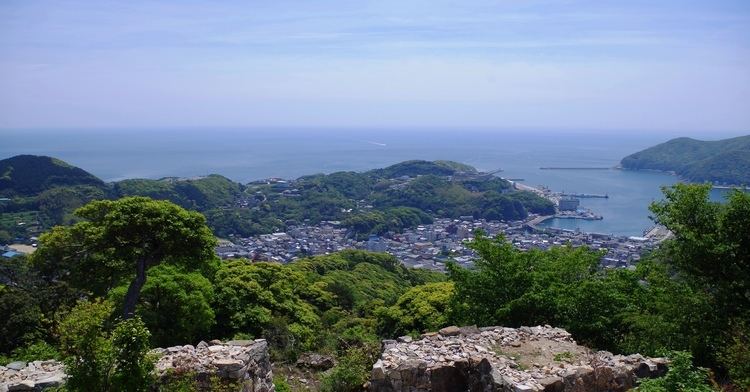Area 708.6 km² | Website tsushima.weebly.com Population 39,983 (2005) | |
 | ||
Time zone Japan Standard Time (UTC+9) Weather 11°C, Wind NW at 11 km/h, 80% Humidity Points of interest Watatsumi Shrine, Banshō‑in Temple, Tsushimarekishiminzoku Museum, Isaribi Park, Ayumodoshi Natural Park | ||
Tsushima (対馬市, Tsushima-shi) is a city located in Nagasaki Prefecture, Japan. It is the only city of Tsushima Subprefecture and it encompasses all of Tsushima Island Archipelago, which lies in the Tsushima Strait north of Nagasaki on the western side of Kyushu, the southernmost mainland island of Japan.
Contents
- Map of Tsushima Nagasaki Prefecture Japan
- History
- Geography
- Islands
- Tsushima cat
- Climate
- Demographics and culture
- Economy
- Tourism
- Airport
- Seaport
- Sister cities
- References
Map of Tsushima, Nagasaki Prefecture, Japan
As of 2005, the city has an estimated population of 39,983 and a population density of 56.42 persons per km2. Its total area is 708.61 km2, 17.3% of the area of Nagasaki Prefecture.
History
An Imperial decree in July 1899 established Izuhara, Sasuna and Shishimi as open ports for trading with the United States and the United Kingdom.
On April 1, 1975, Toyotama Village was promoted to the status of a town. Mine Village was also elevated to the status of a town in the following year.
The modern city of Tsushima was established on March 1, 2004, from the merger of six towns on Tsushima Island: Izuhara, Mitsushima and Toyotama (all from Shimoagata District), and Mine, Kamiagata and Kamitsushima (all from Kamiagata District). Both districts were dissolved as a result of this merger.
Geography
The city of Tsushima is located on Tsushima Island and other small neighbouring islands, lying slightly to the west side of Tsushima Strait, south of the Sea of Japan and north-east of the East China Sea. The island also lies between the Korean Peninsula and the Japanese mainland. Its coastline has a total length of 915 km. Aso Bay, a prominent bay with a rias coastline, is located between the islands. Tsushima lies about 60 km from Iki, 138 km from the city of Fukuoka, and 49.5 km from Busan, South Korea.
Islands
Several other islands encompass Tsushima city, in addition to Kamino-shima and Shimono-shima, both of which makes up the Tsushima Island(s):
Tsushima cat
Native to the island is the Tsushima cat. Present on the islands since ancient times, its numbers have decreased sharply, and it is now listed as an endangered species. As of 2009, it was estimated that only 80 to 100 animals remain.
Climate
Tsushima has a humid subtropical climate (Köppen climate classification Cfa) with very warm summers and cool winters. Precipitation is significant throughout the year, but is much heavier in summer than in winter.
Demographics and culture
The population of Tsushima Island has been decreasing significantly, as evidenced by the 5.2% decrease between the years of 1995 and 2000. Nuclear families are replacing the traditional extended families, therefore, maintaining the number of households at a smaller population. The elderly population makes up for nearly a quarter of the population, much higher than 20.8% of the Nagasaki Prefecture and the national average of 17.3%. Religious traditions on Tsushima Island mirror those of the rest of Japan, with a majority of the population adhering to Buddhism or Shinto.
Economy
Tsushima is ideally located for fishing, and many Tsushima residents exploit this as fishermen. It is also famous for its pearl culture. The natural beauty of the Tsushima Islands ensures there is much to see and the tourism industry is quite substantial. Beaches are crowded with tourists in the summer.
Tourism
Tsushima Island is known for its wildlife. Tsushima offers adventure packages catering primarily to South Koreans. These are generally guided adventure tours consisting of hiking and fishing. Vacation packages are generally booked through South Korean tour agencies. Local English speakers are extremely rare in Tsushima. However, some hotels offer a telephone English translating service. The port town of Izuhara (port of debarkation if arriving from Busan, South Korea) consists of a handful of modern hotels and restaurants. Seafood prices are relatively low, as the islands' primary industry is fishing. Most restaurants hold their seafood in the ocean contained within netted cages, supposedly aiding freshness.
Airport
Seaport
Tsushima has two sea ports, Izuhara and Hitakatsu. Ferries cross to the port of Hakata on Kyūshū a few times per day. Ferries also travel a few times a week to Busan in South Korea.
